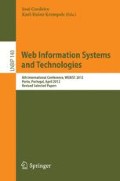Abstract
When looking at the relationship between two terms, we are not only interested on how much they are related, but how we may explain this relationship to the user. This is an open problem in ontology matching, but also in other tasks, from information retrieval to lexicography. In this paper, we propose a solution based on snippets taken from Wikipedia. These snippets are found by looking for connectors between the two terms, e.g. the terms themselves, but also terms that occur often in both articles or terms that link to both articles. With a user study, we establish that this is particularly useful when dealing with not well known relationships, but well-known concepts. The users were learning more about the relationship and were able to grade it accordingly. On real life data, there are some issues with near synonyms, which are not detected well and terms from different communities, but aside from that we get usable and useful explanations of the term relationships.
Access this chapter
Tax calculation will be finalised at checkout
Purchases are for personal use only
Preview
Unable to display preview. Download preview PDF.
References
Budanitsky, A.: Lexical semantic relatedness and its application in natural language processing. Technical report, Department of Computer Science, University of Toronto (1999)
Pavel, S., Euzenat, J.: Ontology matching: state of the art and future challenges. IEEE Transactions on Knowledge and Data Engineering, 1 (2011)
Leacock, C., Miller, G.A., Chodorow, M.: Using corpus statistics and wordnet relations for sense identification. Comput. Linguist. 24, 147–165 (1998)
Slimani, T., Ben Yaghlane, B., Mellouli, K.: A new similarity measure based on edge counting. World Academy of Science, Engineering and Technology 23, 34–38 (2006)
Strube, M., Ponzetto, S.P.: Wikirelate! computing semantic relatedness using wikipedia. In: Proceedings of the 21st National Conference on Artificial Intelligence, vol. 2, pp. 1419–1424. AAAI Press (2006)
Islam, A., Inkpen, D.: Semantic text similarity using corpus-based word similarity and string similarity. ACM Trans. Knowl. Discov. Data 2, 10:1–10:25 (2008)
Milne, D., Witten, I.H.: An effective, low-cost measure of semantic relatedness obtained from wikipedia links. In: Proceedings of the First AAAI Workshop on Wikipedia and Artificial Intelligence, WIKIAI 2008, pp. 25–30 (2008)
Ramos, J.: Using tf-idf to determine word relevance in document queries. Department of Computer Science, Rutgers University, Piscataway, NJ (2003)
Navarro, G.: A guided tour to approximate string matching. ACM Comput. Surv. 33, 31–88 (2001)
Gabrilovich, E., Markovitch, S.: Computing semantic relatedness using wikipedia-based explicit semantic analysis. In: Proceedings of the 20th International Joint Conference on Artifical Intelligence, IJCAI 2007, pp. 1606–1611. Morgan Kaufmann Publishers Inc., San Francisco (2007)
Nakayama, K., Hara, T., Nishio, S.: Wikipedia link structure and text mining for semantic relation extraction. In: Workshop on Semantic Search (SemSearch 2008) at the 5th European Semantic Web Conference (ESWC 2008), pp. 59–73 (2008)
Shvaiko, P., Giunchiglia, F., da Silva, P.P., McGuinness, D.L.: Web Explanations for Semantic Heterogeneity Discovery. In: Gómez-Pérez, A., Euzenat, J. (eds.) ESWC 2005. LNCS, vol. 3532, pp. 303–317. Springer, Heidelberg (2005)
Dhamankar, R., Lee, Y., Doan, A., Halevy, A., Domingos, P.: imap: discovering complex semantic matches between database schemas. In: Proceedings of the 2004 ACM SIGMOD International Conference on Management of Data, pp. 383–394. ACM (2004)
Chai, X., Sayyadian, M., Doan, A., Rosenthal, A., Seligman, L.: Analyzing and revising data integration schemas to improve their matchability. Proceedings of the VLDB Endowment 1, 773–784 (2008)
Noy, N.F., Griffith, N., Musen, M.A.: Collecting Community-Based Mappings in an Ontology Repository. In: Sheth, A.P., Staab, S., Dean, M., Paolucci, M., Maynard, D., Finin, T., Thirunarayan, K. (eds.) ISWC 2008. LNCS, vol. 5318, pp. 371–386. Springer, Heidelberg (2008)
Shvaiko, P., Euzenat, J.: Ten Challenges for Ontology Matching. In: Meersman, R., Tari, Z. (eds.) OTM 2008, Part II. LNCS, vol. 5332, pp. 1164–1182. Springer, Heidelberg (2008)
Bernstein, P., Melnik, S.: Model management 2.0: manipulating richer mappings. In: Proceedings of the 2007 ACM SIGMOD International Conference on Management of Data, pp. 1–12. ACM (2007)
Finkelstein, L., Gabrilovich, E., Matias, Y., Rivlin, E., Solan, Z., Wolfman, G., Ruppin, E.: Placing search in context: the concept revisited. ACM Trans. Inf. Syst. 20, 116–131 (2002)
Rodgers, J.L., Nicewander, W.A.: Thirteen ways to look at the correlation coefficient. The American Statistician 42, 59–66 (1988)
Dillman, D.A., Bowker, D.K.: The Web Questionnaire Challenge to Survey Methodologists, pp. 159–178. Pabst Science Publishers (2001)
Martin, R.C., Bolter, J.F., Todd, M.E., Gouvier, W.D., Niccolls, R.: Effects of sophistication and motivation on the detection of malingered memory performance using a computerized forced-choice task. Journal of Clinical and Experimental Neuropsychology 15, 867–880 (1993)
Smyth, J.D., Dillman, D.A., Christian, L.M., Stern, M.J.: Comparing check-all and forced-choice question formats in web surveys. Public Opinion Quarterly 70, 66–77 (2006)
Author information
Authors and Affiliations
Editor information
Editors and Affiliations
Rights and permissions
Copyright information
© 2013 Springer-Verlag Berlin Heidelberg
About this paper
Cite this paper
Mathiak, B., Peña, V.M.M., Wira-Alam, A. (2013). Extracting Term Relationships from Wikipedia. In: Cordeiro, J., Krempels, KH. (eds) Web Information Systems and Technologies. WEBIST 2012. Lecture Notes in Business Information Processing, vol 140. Springer, Berlin, Heidelberg. https://doi.org/10.1007/978-3-642-36608-6_17
Download citation
DOI: https://doi.org/10.1007/978-3-642-36608-6_17
Publisher Name: Springer, Berlin, Heidelberg
Print ISBN: 978-3-642-36607-9
Online ISBN: 978-3-642-36608-6
eBook Packages: Computer ScienceComputer Science (R0)

